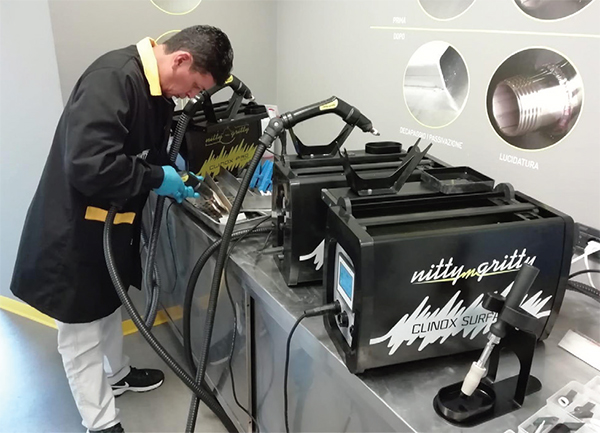African Fusion talks to the technical director of Arcstrike, Sean Blake, about an innovative and sophisticated polishing, pickling, passivating and marking solution for stainless steel.
Click to download and read pdf
ArcStrike is a new company founded on the principle of introducing innovative technology to the local welding market, with a view to making a difference with respect to the quality and productivity being achieved by fabricators and manufacturers. An example of a technology being introduced into South Africa by ArcStrike is the Nitty Gritty range of sophisticated pickling and passivating equipment for stainless steel welds and surfaces.

Traditionally, stainless steel welds are pickled using very strong pickling acids such as hydrofluoric acid (HF) and nitric acid for passivating. These chemicals present significant handling and safety concerns. The Nitty Gritty alternative couples electrochemical cleaning machines with a range of chemical solutions with safer acidity (pH) levels carefully matched to the process and application.
These Italian machines use inverter-based power sources under sophisticated electronic control to create an electrochemical cell between a stainless steel surface such as a weld and an application pad coated in one of the company’s chemical solutions. In the simplest systems, the sponge or cloth pad is dipped into the solution before being wiped over the treatment surface. The more sophisticated Nitty Gritty versions, however, use a pump to apply the chemical solutions to the applicator, so that dipping is not required. The electrically charged pad is continuously wiped over the treatment area of the weld or stainless surface.
During pickling, the electrochemical current passing between the plate and the brush breaks down the oxide layer on the stainless steel surface, effectively removing it. When re-passivating to build up the oxide layer to the thickness required to transfer optimum corrosion resistance to the stainless steel below, passivating pastes are used with oxidising acids such a nitric or citric acid and, according to Nitty-Gritty, phosphoric acid also enhances the natural process of passivation.
The principle is not new and transformer-based and welding machine-based versions are available, but these machines are all dipping based and use the simplest of power sources to provide the electrochemical current. Welding machines tend to be designed to strike an arc, which can easily happen when being used for cleaning, resulting in micro pits, which are potential sites for pitting corrosion. Electronic control built into Nitty Gritty inverters prevents this. Accurate current control avoids heat generation, which will cause increased consumption of electrochemical solutions and wear on the cleaning pads. Energy consumption is also significantly improved by using inverter technology, compared to transformer based alternatives.
A key aim of adopting electrochemical cleaning is also to improve safety. The solutions used are all more dilute and therefore safer than traditional HF acid for pickling and nitric acid passivating solutions.
And while slightly stronger electrochemical solutions are used with Nitty Gritty equipment for polishing and cleaning heavy weld oxide layers, for lighter oxide layers a neutral solution is available that is ideal for use in food and pharmaceutical applications, where strongly acidic solutions will react adversely with the nutrients or pharmaceuticals of the end products.
Nitty Gritty offers a simple chemical colour test to determine the grade of the stainless steel being treated, so that the correct treating chemicals can always be identified. A passive layer tester is also available to ensure optimum corrosion resistance has been obtained.
In addition to cleaning, these machines can permanently mark stainless steel surfaces with logos or product numbers using a selective electroplating or micro-etching process.
Other products in the Nitty-Gritty range include Pickle & Clean and Deox & FIT, which are alternatives to pickling pastes and gels that are ideally suited to the food and medical industries where aggressive chemicals may not be used. A tape or a wipe is first used to clean the area being treated before a neutralising solution is applied to the cleaned area.
“We are striving to help fabricators to improve their quality and productivity and to reduce their welding costs,” says Blake “So we are on the hunt for technologies, clients and services that will achieve this.
“We also wish to improve the lives of welding personnel, by introducing cost-effective services to help welders, welding co-ordinators and welding inspectors to achieve their professional goals,” Blake concludes.